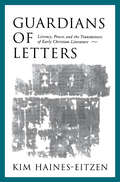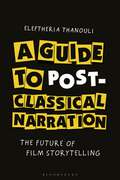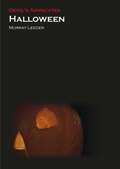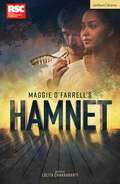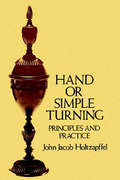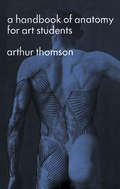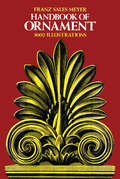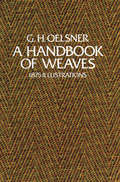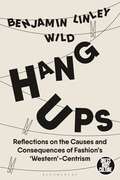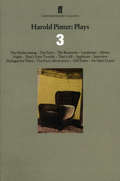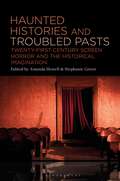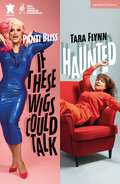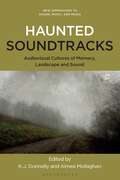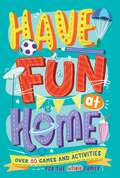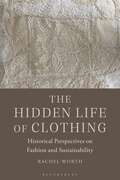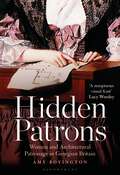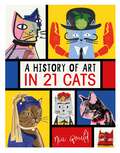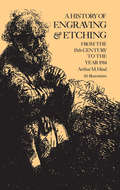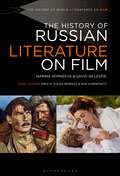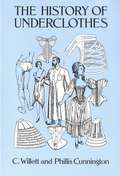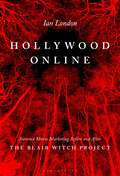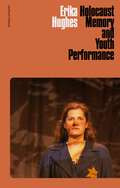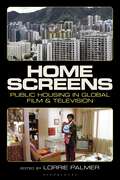- Table View
- List View
Guardians Of Letters: Literacy, Power, And The Transmitters Of Early Christian Literature
by Kim Haines-EitzenA Guide to Post-classical Narration: The Future of Film Storytelling
by Dr. Eleftheria ThanouliIn A Guide to Post-classical Narration, Eleftheria Thanouli expands and substantially develops the innovative theoretical work of her previous publication, Post-classical Cinema: an International Poetics of Film Narration (2009). A Guide to Post-classical Narration: The Future of Film Storytelling presents a concise and comprehensive overview of the creative norms of the post-classical mode of narration. With dozens of cases studies and hundreds of color stills from films across the globe, this book provides the definitive account of post-classical storytelling and its techniques. After surfacing in auteur films in varied production milieus in the 1990s, the post-classical options continued to gain ground throughout the 2000s and 2010s, gradually fertilizing several mainstream productions in Hollywood. From Lars von Trier's Europa (1991) to Zack Snyder's Army of the Dead (2021) and Baz Luhrmann's Elvis (2022), the post-classical narration has shown not only impressive resilience but also tremendous creativity in transforming its key formal principles, such as fragmented and multi-thread plotlines, hypermediated realism, parody, graphic frame construction, complex chronology, and intense self-consciousness. Through the meticulous textual analysis of the post-classical works, Eleftheria Thanouli addresses head-on a series of methodological questions in narrative research and brings the tradition of historical poetics back into the limelight. By reinforcing her previous work with numerous new films as well as more nuanced narrative terms and concepts, she not only strengthens her position on post-classical cinema but also establishes the relevance of formalist analysis in the study of film today.
Halloween (Devil's Advocates)
by Murray LeederThe 1970s represented an unusually productive and innovative period for the horror film, and John Carpenter's Halloween (1978) is the film that capped that golden age – and some say ruined it, by ushering in the era of the slasher film. Considered a paradigm of low-budget ingenuity, its story of a seemingly unremarkable middle-American town becoming the site of violence on October 31 struck a chord within audiences. The film became a surprise hit that gave rise to a lucrative franchise, and it remains a perennial favourite. Much of its success stems from the simple but strong constructions of its three central characters: brainy, introverted teenager Laurie Strode, a late bloomer compared to her more outgoing friends, Dr. Loomis, the driven, obsessive psychiatrist, and Michael Myers, the inexplicable, ghostlike masked killer.Film scholar Murray Leeder offers a bold and provocative study of Carpenter's film, which hopes to expose qualities that are sometime effaced by its sequels and remakes. It explores Halloween as an unexpected ghost film, and examines such subjects as its construction of the teenager, and the relationship of Halloween the film to Halloween the holiday, and Michael Myers's brand of "pure evil." It is a fascinating read for scholars and fans alike.
Hamnet (Modern Plays)
by Maggie O'Farrell'She's like no one I've ever met... She's like fire and water all at once.'Warwickshire, 1582. Agnes Hathaway, a natural healer, meets the Latin tutor, William Shakespeare. Drawn together by powerful but hidden impulses, they create a life together and make a family.As William moves to London to discover his place in the world of theatre, Agnes stays at home to raise their three children but she is the constant presence and purpose of his life.When the plague steals 11-year-old Hamnet from his loving parents, they must each confront their loss alone. And yet, out of the greatest suffering, something of extraordinary wonder is born.This new play based on Maggie O'Farrell's best-selling novel and adapted by award-winning playwright Lolita Chakrabarti (Life of Pi, Red Velvet, Hymn), pulls back a curtain on the imagined family life of the greatest writer in the English language. Hamnet is a love letter to passion, birth, grief and the magic of nature. This updated and revised edition was published to coincide with the West End transfer of the original RSC production in October 2023.
Hand or Simple Turning: Principles and Practice (Dover Woodworking Ser.)
by John Jacob HoltzapffelGreat Victorian classic offers full coverage of basic lathe techniques: history and development, special apparatus, softwood turning, hardwood turning, metal turning, more. Projects include billiard ball, egg cups, ash trays, vases, jardiniers, others. First inexpensive paperback reprint.
A Handbook of Anatomy for Art Students (Dover Anatomy For Artists Ser.)
by Arthur ThomsonSkeletal structure, muscles, heads, special features. Exhaustive text, anatomical figures, undraped photos. Male and female. 337 illustrations.
Handbook of Ornament: A Grammar Of Art, Industrial And Architectural Designing In All Its Branches, For Practical As Well As Theoretical Use (classic Reprint) (Dover Pictorial Archive Ser.)
by Franz Sales MeyerRepublished unabridged from the final comprehensive edition, this work contains the largest single-volume collection of classical art motifs ever compiled. It reproduces material from Greek and Roman, medieval European, Islamic, Renaissance, baroque, and early nineteenth-century art, architecture, and design — in all, presenting artists, crafters, and students with more than 3,000 designs.Featured design elements include networks, Gothic tracery, geometric designs, akanthos leaves, lotus ornamentation, animal ornamentation, grotesque figures, fret bands, chains, interlacements, rosettes, undulations, spirals, link borders, cresting borders, finials, crockets, gargoyles, foliations, panels, repeated ornaments, and hundreds of other elements. Other plates show decorated pottery vases, religious utensils, weapons, furniture, lamps, jewelry, and other artifacts, in addition to heraldic motifs and ornamental letters.
A Handbook of Weaves: 1875 Illustrations
by G. H. OelsnerTo anyone concerned with the design of fabrics, the structure of the cloth is, of course, of prime importance for achieving best results and most satisfying ultimate appearance. Oelsner's A Handbook of Weaves, long the most reliable and comprehensive source of information on the subject, will save you hours of research work and offer information necessary for new cloth effects. It covers the field thoroughly from the simple draft and plain weave to the more complicated fancy weaves, with a clear, lucid text and with 1,875 working diagrams.Just a few of the many weaves fully explained, differentiated, and illustrated in this volume are irregular, double-stitched, and filling satins; basket and rib weaves; steep, undulating, broken, offset, corkscrew, interlocking, herringbone, and fancy twills; honeycomb and lace weaves; tricot and metalassé weaves; corded, piqué, and kersey weaves; and literally hundreds more.The outstanding section on crépe weaves (over 45 pages, 342 weaves) explains 10 different methods, including arranging other weaves, rearranging warp threads, interlocking a weave over another, drafting a weave in four squares, and transporting weaves in checkerboard order.One of the work's most valuable features, particularly to the manufacturer, is in the section which shows with text and picture how from a simple swatch of material one may obtain the full details of construction and layout of any fabric made: weave and color patterns, number of threads per square inch, weight of cloth, sizes of warp yarn and filling yarn, etc.A full chapter is given showing how interesting effects may be obtained by arrangement of yarns in contrasting colors in either warp or filling or both, and how effects can be produced by combining weave and color patterns in the same cloth. A large number of examples, with 207 diagrams, show color effects in twills, basket weaves, crépes, etc.Other topics covered here that are rarely found in textile design books are breaks or recesses in the cloth, weaves that deflect certain threads, broche fabrics, double transposed textures, reform weaves, the determination of the best weaves, the determination of the best types of weave for specific textures and many similar topics.These and many other special features add to this unsurpassed collection's immense value for the textile manufacturer, the designer, the stylist, the hand-loom weaver, the power-loom weaver, and the teacher and student of textiles. It is at once a fully indexed reference, a lucid "how-to-do-it" book, and a storehouse of unusual information and practical suggestions.Includes a supplement on the analysis of weaves and fabrics.
Hang-Ups: Reflections on the Causes and Consequences of Fashion’s ‘Western’-Centrism (Dress, Body, Culture)
by Benjamin Linley WildThe Covid-19 pandemic heightened people's awareness of long-standing inequalities within the fashion industry. Amid calls for greater accountability and ethical awareness, efforts are being made within and beyond the industry, chiefly in the cultural and education sectors, to decentralize fashion: to make the conception, creation and consumption of fashionable dress and appearance less 'western'-centric.Supporting this premise, Hang-Ups argues that purposeful and permanent change within the fashion industry and fashion education is more likely if it is understood how the contemporary industry became 'western'-centric. To institute effective change, it is necessary to revert to first principles and understand how the fashion industry developed into what it is today. During a period when the concepts of fashion, history and culture are being intensely scrutinized, and with suggestions they are reaching their nadir, the imperative to understand the extent to which they relate, and facilitate the presentation of people's fashionable bodies, is urgent. Hang-Ups explores the origins and consequences of the fashion industry's 'western'-centrism by focusing on nine binaries, defined in the crucible of empire, that continue to be sites of negotiation as the 'west's' traditions and ideals are contested by different cultural perspectives and changing global realities.
Harold Pinter Plays 3: The Homecoming; Old Times; No Man’s Land (Pinter, Harold Ser.)
by Harold PinterThis revised third volume of Harold Pinter's work includes The Homecoming, Old Times, No Man's Land, four shorter plays, six revue sketches and a short story. It also contains the speech given by Pinter in 1970 on being awarded the German Shakespeare Prize. The Homecoming 'Of all Harold Pinter's major plays, The Homecoming has the most powerful narrative line... You are fascinated, lured on, sucked into the vortex.' Sunday Telegraph 'The most intense expression of compressed violence to be found anywhere in Pinter's plays.' The Times Old Times 'A rare quality of high tension is evident, revealing in Old Times a beautifully controlled and expressive formality that has seldom been achieved since the plays of Racine.' Financial Times 'Harold Pinter's poetic, Proustian Old Times has the inscrutability of a mysterious picture, and the tension of a good thriller.' Independent No Man's Land 'The work of our best living playwright in its command of the language and its power to erect a coherent structure in a twilight zone of confusion and dismay.' The Times
Haunted Histories and Troubled Pasts: Twenty-First-Century Screen Horror and the Historical Imagination
Haunted Histories and Troubled Pasts speaks to how a transnational array of recent screen entertainments participate, through horror, in public discourses of history, the social and creative work of reshaping popular understanding of our world through the lens of the past.Contemporary film and television – and popular screen cultures more generally – are distinguished by their many and varied engagements with history, including participation in worldwide movements to reconcile past losses and injuries with present legacies. The chapters in this collection address themselves to 21st-century screen horror's participation in this widespread fascination with and concern for the historical - its recurrent reimagining of the relation between the past and present, which is part of its inheritance from the Gothic. They are concerned with the historical work of horror's spectral occupations, its visceral threats of violence and its capacity for exploring repressed social identities, as well as the ruptures and impositions of colonization and nationhood.Trauma is a key theme in this book, examined through themes of war and genocide, ghostly invasions, institutionalized abuse, apocalyptic threat and environmental destruction. These persistent, fearful reimaginings of the past can take many lurid – sometimes tritely generic – forms. Together, these chapters explore and reflect upon horror's ability to speak through them to the unspoken of history, to push the boundaries and probe the fault-lines and ideological impositions of received historical narratives – while reminding us that history and the historical imagination persist as sites of contention.
Haunted & If These Wigs Could Talk (Modern Plays)
by Tara Flynn Panti BlissTHISISPOPBABY & The Abbey Theatre presentIf These Wigs Could Talk by Panti BlissIf These Wigs Could Talk meets Panti, a drag queen at fifty-three, after a lifetime of showbiz, shenanigans and making a show of herself, taking this moment to question what her purpose and place in the world is now. Via salacious stories, impassioned polemics, some seriously funny soul searching and a few unvarnished truths, Panti takes us from rural Mayo to London's glittering West End to the Ambassador's residence in Vienna where, along the way, the answer to the question presents itself when she least expects it. Panti warmly invites you to learn from her mistakes, laugh at her failures and revel in her triumphs.Haunted by Tara FlynnWhat happens when you hit the floor and lose all of your marbles? Ask Tara Flynn: a fame-adjacent actor turned advocate for the campaign to Repeal Ireland's Eighth Amendment. The country voted Yes and the whirlwind of publicity and abuse came to an end, and crashing to the floor is where Tara found herself. Down there, she realised the whirlwind had conveniently kept her from dealing with the death of her dad.This is one woman's journey back from the floor. A funny, moving tale of grief, campaigning for civil rights, the offline impact of online abuse, crashing to the ground and fighting to tell your own story.
Haunted Soundtracks: Audiovisual Cultures of Memory, Landscape, and Sound (New Approaches to Sound, Music, and Media)
The turn of the millennium has heralded an outgrowth of culture that demonstrates an awareness of the ephemeral nature of history and the complexity underpinning the relationship between location and the past. This has been especially apparent in the shifting relationship between landscape, memory and sound in film, television and other media. The result is growing interest in soundtracks, as part of audiovisual culture, as well as an interest in the spectral aspects of culture more generally. This collection of essays focuses on audiovisual forms that foreground landscape, sound and memory. The scope of inquiry emphasises the ghostly qualities of a certain body of soundtracks, extending beyond merely the idea of 'scary films' or 'haunted houses.' Rather, the notion of sonic haunting is tied to ideas of trauma, anxiety or nostalgia associated with spatial and temporal dislocation in contemporary society. Touchstones for the approach are the concepts of psychogeography and hauntology, pervasive and established critical strategies that are interrogated and refined in relation to the reification of the spectral within the soundtracks under consideration here.
Have Fun at Home
by Alison Maloney Christopher StevensTime at home is much more fun when it is shared. Whatever games and activities you dream up, they take on a whole new meaning when the whole family get involved. So whether it's the weekend, the holidays or that precious free hour at the end of a busy day, here are over 80 ideas for activities that will have everyone grinning from ear to ear. If you've got energy to burn, this book contains sports and games ideas to exercise both mind and muscles. If it's new toys you want, there are all sorts of ingenious and inexpensive playthings to make within these pages. If you need ideas for indoor fun, there's lots to do when it's raining outside. And if you want to sneak a little education into playtime, you'll even find a few facts hidden among the fun.
The Hidden Life of Clothing: Historical Perspectives on Fashion and Sustainability
by Rachel WorthSince the democratisation of the clothing industry in the early 19th century, buyers have become increasingly disconnected from the creative and human aspects of the production of clothing. Arguably clothing is now valued less for its aesthetic qualities or because of the hours spent in its making, but more for the extent to which it serves current 'fashion'. In a climate of increasing anxiety about the environmental and social impact of the contemporary global fashion industry, Rachel Worth suggests that, rather than seeking solutions only in the present, looking to history can assist in understanding better the challenges consumers face today in making decisions about the contents of their wardrobes, which, in turn, will impact on the nature of the future global fashion industry. She does not seek to offer simplistic historical solutions to contemporary problems, but explores ways in which it might be possible to bridge divides between knowledge of the past, current individual choice, and possible directions for future action. The more we know about our clothes, the less likely it is that we will wear an item of clothing only a few times before replenishing it with newer purchases that are 'on trend'. By taking ownership of our personal clothing choices rather than feeling pressurised to respond to sophisticated marketing and to 'influencers', this book suggests how we might rethink our wardrobes in philosophical and practical ways in order to create a sense of order and beauty in our lives and to wrest control back from the increasing chaos of seemingly endless choice that perpetuates unsustainable, impersonal and fast fashion.
Hidden Patrons: Women and Architectural Patronage in Georgian Britain
by Amy BoyingtonAn enduring myth of Georgian architecture is that it was purely the pursuit of male architects and their wealthy male patrons. History states that it was men who owned grand estates and houses, who commissioned famous architects, and who embarked upon elaborate architectural schemes. Hidden Patrons dismantles this myth - revealing instead that women were at the heart of the architectural patronage of the day, exerting far more influence and agency than has previously been recognised. Architectural drawing and design, discourse, and patronage were interests shared by many women in the eighteenth century. Far from being the preserve of elite men, architecture was a passion shared by both sexes, intellectually and practically, as long as they possessed sufficient wealth and autonomy.In an accessible, readable account, Hidden Patrons uncovers the role of women as important patrons and designers of architecture and interiors in eighteenth-century Britain and Ireland. Exploring country houses, Georgian townhouses, villas, estates, and gardens, it analyses female patronage from across the architectural spectrum, and examines the work of a range of pioneering women from grand duchesses to businesswomen to lowly courtesans. Re-examining well-known Georgian masterpieces alongside lesser-known architectural gems, Hidden Patrons unearths unseen archival material to provide a fascinating new view of the role of women in the architecture of the Georgian era.
A History of Art in 21 Cats: From the Old Masters to the Modernists, the Moggy as Muse: an illustrated guide
by Nia GouldArt history has been given a fun feline makeover. Discover the basics of important art movements through a host of beautifully illustrated cats, each one inspired by a specific period in art history. From Surrealism to Cubism, Abstract Expressionism to Ancient Egyptian art, these creative cats will introduce you to key themes and provide you with all of the inspiration you need if you want to create your own version.Each illustrated cat comes with an overview of the art movement that it represents, plus a breakdown of the cats features, explaining the relevance of each. Accompanied by fun, informative captions, each element - from faces and fur to patterns, shapes and colours - provides a quirky, accessible insight into the history of art.More than just a reference book, A History of Art in 21 Cats is perfect for art enthusiasts and cat lovers alike.
A History of Engraving and Etching
by Arthur M. HindArthur Mayger Hind (1880–1957) was a leading historian of engraving, one of the most highly respected art historians of modern times. Keeper of Prints and Drawings at the British Museum and Professor of Fine Art at Oxford, he was the author of the most complete history of etching and engraving that has yet been written. This book, formerly out of print for many years, contains references to every etcher or engraver worthy of mention from the early fifteenth century to 1914, and it gives a fair account of influences, artistic repercussions, and accomplishments of each individual.Beginning with a chapter on processes and methods of the twin arts, in which he covers line-engraving, etching, biting and stopping-out, tone processes, the tools used in the various methods, and so on, the author proceeds with a text that is fabled among artists, art historians, teachers, and students for its richness of detail and the brilliance of its author’s obvious genius for research and criticism. He begins with the anonymous engravers of the fifteenth century, moves through Holland, Italy, and Germany to the great masters of engraving and the beginnings of etching in the sixteenth century, through the portrait engravers, master etchers, the practitioners of mezzotint, aquatint, crayon manner and stipple, and color print makers, to modern etching in the period prior to World War I. All along the way there are illustrations: over 100 magnificent works by Dürer, Finiguerra, Cranach, Lucas Van Leyden, Parmigiano, Van Dyck, Rembrandt, van Ruysdael, Blake, Tiepolo, Piranesi, Turner, Boucher, Goya, Millet, Whistler, and scores of others. All but seven of these plates have been reproduced from new photographs and are even sharper and clearer than those in the original editions of Hind's great text.As an aid to students of art history, there is a massive Index of more than 2,500 artists mentioned in the text, with their dates and brief individual biographical data. Furthermore, there is a classified chronological list, arranged by country, of important artists, movements, and styles, and the engravers and etchers who were influenced by them. Finally, there is a bibliography that is valuable for further reference work.
The History of Russian Literature on Film (The History of World Literatures on Film)
by Marina Korneeva David GillespieUnlike most previous studies of literature and film, which tend to privilege particular authors, texts, or literary periods, David Gillespie and Marina Korneeva consider the multiple functions of filmed Russian literature as a cinematic subject in its own right-one reflecting the specific political and aesthetic priorities of different national and historical cinemas. In this first and only comprehensive study of cinema's various engagements of Russian literature focusing on the large period 1895-2015, The History of Russian Literature on Film highlights the ways these adaptations emerged from and continue to shape the social, artistic, and commercial aspects of film history.
The History of Underclothes
by C. Willett Cunnington PhiIlis Cunnington". . . thoroughness and most impressive scholarship . . . much entertaining detail and . . . pleasant humour." — The Times Literary Supplement (London)Underwear — practical garments with a utilitarian function or body coverings that serve an erotic purpose? As this fascinating and intelligently written study shows, the role played by underclothing over the last several centuries has been a varied one.In a well-documented, profusely illustrated volume combining impressive scholarship with an entertaining, often humorous style, two distinguished clothing historians consider undergarments worn by the English over the past 600 years. Beginning with the Middle Ages, the authors cover centuries of clothing history, including the Tudor period, the Restoration, the Victorian and Edwardian eras, and the twentieth century up to the eve of World War II. Drawing on extensive, research, the Cunningtons illuminate the role and function of underwear: it protected the wearer against the elements, supported costume shapes, served as an erotic stimulus, symbolized class distinctions, and fulfilled other social, sanitary, and economic functions. Enhancing the detailed, comprehensive text are more than 100 period illustrations and photographs depicting a laced-up bodice of the twelfth century, embroidered linen drawers of the sixteenth century, a hooped petticoat support in bentwood (c. 1750), footed long drawers (1795), nineteenth-century bustles, early nineteenth-century corsets for men, "Frillies for the Tiny Lady" (1939), and much more. A bibliography, appendix, and index complete a valuable reference work that will appeal to costume historians, sociologists, and other readers.
Hollywood Online: Internet Movie Marketing Before and After The Blair Witch Project
by Dr. Ian LondonHollywood Online provides a historical account of motion picture websites from 1993 to 2008 and their marketing function as industrial advertisements for video and other media in the digital age.The Blair Witch Project is the most important example of online film promotion in cinema history. Over the last thirty years only a small number of major and independent distributors have converted internet-created buzz into box-office revenues with similar levels of success. Yet readings of how the film's internet campaign broke new ground in the summer of 1999 tend to minimize, overlook or ignore the significance of other online film promotions. Similarly, claims that Blair initiated a cycle of imitators have been repeated in film publications and academic studies for more than two decades. This book challenges three major narratives in studies about online film marketing: Hollywood's major studios and independents had no significant relationship to the internet in the 1990s; online film promotions only took off after 1999 because of Blair; and Hollywood cashed-in by initiating a cycle of imitators and scaling up corporate activities online. Hollywood Online tests these assumptions by exploring internet marketing up to and including the film's success online (Pre-Blair, 1993-9), then by examining the period immediately after Blair (Post-Blair, 2000-8) which broadly coincides with the rise and decline of DVD, as well as the emergence of the social media sites MySpace, Facebook and Twitter.
Holocaust Memory and Youth Performance
by Erika HughesThrough an examination of children's and youth plays and performances about the Holocaust from Germany, Israel, and the United States, this book offers an entirely new way of looking at the vital role of youth performance in coping with the legacy of historical tragedy. As the first book-length critical examination of this subject, Holocaust Memory and Youth Performance considers plays that are produced by major theatre companies alongside performances written by young authors and pieces taken from the diaries and memoirs of those who experienced the Holocaust as children or adolescents. While youth-focused plays about the Holocaust have been in the repertories of top professional companies throughout the world for decades and continue to be performed in theatres, schools, and community centers, they are often neglected in concentrated and comparative studies of Holocaust theatre. Erika Hughes fills this gap by examining plays (including The Diary of Anne Frank and Ab heure heißt Du Sara), musicals, performances, scripts, a rock concert, a performance on Instagram, and pedagogically-focused works of applied theatre – a diverse collection of performances for young audiences that tell the stories of young people who experienced the Holocaust. Adopting Hannah Arendt's notion of natality as a powerful framework, this study examines the ways in which youth-theatre performances make a vital contribution to intergenerational witnessing and the collective memory of the Holocaust.
Home Screens: Public Housing in Global Film & Television
How do film and television makers around the world depict public housing? Why is public housing so often chosen as the backdrop for drama, horror, social critique, rebellion, violence, artistic creativity, explorations of race relations and political intrigue?Home Screens answers these questions by examining the ways in which socialized housing projects around the world are represented on screen. The volume brings together a diverse group of interdisciplinary scholars, who explore documentary and fictional portrayals of the architecture of public housing, and the communities that inhabit it, ranging from the 1950s to the present. Examining international film and media texts such as Die Architekten (1990), Swagger (2016), Cooley High (1975), Mee-Pok Man (1995), Treme (2010–2013), Mamma Roma (1962), The Pruitt-Igoe Myth (2011), and Below the Lion Rock (1972–1976), essays within this book consider public and private attitudes toward socialised housing, explaining how onscreen representations shape perceptions of these ubiquitous, often-stigmatized urban locations.
Homes for a Changing Climate: Adapting Our Homes and Communities to Cope with the Climate of the 21st Century
by Will AndersonAn exploration into the history of our collective response to the challenges of extreme weather conditions and climate.At the beginning of the twenty-first century, the world finally woke up to the reality of climate change and began the arduous task of freeing itself from dependence on fossil fuels. But the time lag in the Earth's ecosystem is such that our best efforts to cut carbon today will make little difference to the changing climate of the next 30 years. As we work towards a secure, low-carbon future, we must address the changes that are already taking place in the planet's climate. We must learn to live with higher temperatures, intense rainstorms, rising sea levels and prolonged drought. We must also confront the secondary impacts of climate change, especially on energy and food security.Britain has a mild, temperate climate where occasional weather extremes tend to have serious impacts because we are simply not prepared for them. Yet across the world, communities have been living with such extremes for millennia. If we have the imagination to learn from others and rethink the ways we build and live together, we can face this unsettling future with confidence.Homes for a Changing Climate celebrates this collective wisdom, exploring traditional and contemporary responses to the challenges of climate and illustrating the many ways in which houses can be designed, built and adapted to cope with these challenges. Examples are drawn from across Europe including the supervolcano of Thera, the 100mph winds of the Western Isles, and the cutting-edge eco-building projects in Britain. Based on the climate projections for the UK published by the Met Office in June 2009, Homes for a Changing Climate combines inspiring case studies, striking photography and practical advice to create a book of imagination and hope in uncertain times.
